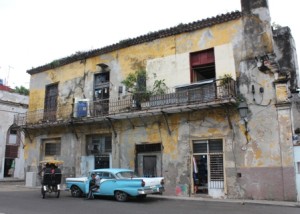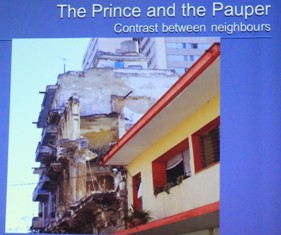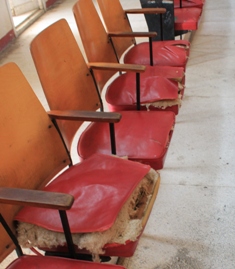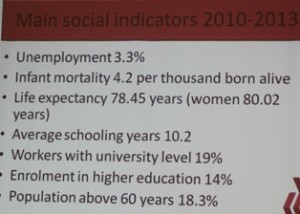NPCA Goes To Cuba! Part VIII (Final Blog) Cuba Today
The conditions of Cuba today are obvious from first sight. This is a land that stopped progress decades ago when the Soviet Union turned its back on the island. The topic that is on everyone’s list of concerns when meeting Cubans is housing. Their housing. There is nowhere to live, though the neighborhoods in greater Havana, and other cities, are full of abandoned and crumbling architecture, beautiful pre-revolutionary housing crying out to be saved. After the revolution of 1959, and the U.S. embargo, most of Havana fell into a dilapidated state. By 1968, all privately owned businesses were nationalized. After the collapse of the Soviet Union in 1991, Cuba lost billions of dollars in aid from Russia. And the U.S., 90 miles away, wasn’t helping them.

Houses today in Cuba
Now, after fifty plus years, Cuba is turning to tourism to right this socialist country where an estimated 15% of all Cubans live elsewhere, and 60% of those living on the island are of retirement age.
Here is an example of what that means to those who are left on the island. The house on the right has a relative in the U.S. who is sending money back to rebuild the family home. There is no family money being sent to rebuild the home to the left in this photo.

In Old Havana, effort has also gone into rebuilding for tourist purposes, and a number of streets and squares have been rehabilitated. Old Havana is a large area, and the restoration efforts concentrates on less than 10% of the city.

Condition of chairs at an Arts School we visited
Most of this information comes from an overview of the growth and development of Havana given by a brilliant and well-spoken Cuban architect who traced the city’s changing architectural and social shifts since its beginnings in the 1500s to the present day, well, actually, to the “special period” which is the name given to the years since the Soviets left Cuba to, we might say, ‘twist in the wind.’

In a number of slides, the architect explained the current social and economic conditions in Cuba based on material prepared by the www.theholmteam.com/Havana.Workshops 2013



According to another recent article in USA Today on the Trade Fair in Havana conditions will change for the better, and soon. The newspaper article quotes, Ralph Patino, a Cuban-American attorney who is attending the Fair. “”We’re entering a very dark room and feeling our way through to get to the other side,” he says, describing the current situation with the U.S. and Cuba.
Patino who lives in Miami created a company, shortly after Obama’s December 17, 2015 announcement, to sell construction materials to Cuban entrepreneurs and government businesses that help the Cuban people, such as hospitals. In an island where finding a piece of plywood, a toilet seat or a particular screw can take days or weeks – if they can be found at all – Patino believes he stands a good chance of filling that hole in the Cuban market.

I had this car in high school!
While in Havana this past week he met with government officials to approve a plan that would start with a wholesale warehouse at the Port of Mariel outside of Havana. He said the plan would eventually expand to opening several big box-style construction stores around this capital city and then throughout the island.
“It’s obvious that the Cuban government wants to open their markets to U.S. businesses,” Patino said.
By chance, I met an American in the square in the city of Cienfuegos. He has been living in Cuba for 18 years, and says he has lived all over the world but that he finds Cuba a country that he can’t quite understand. While we saw no violence or street crime in our eight days in-country, he said Cuba is a violent country. When asked what will happen when the embargo is lifted, he says it will never happen as the military controls the country and they do not want any loosening of their power.
That said, it appeared to me that the Cubans we met were warm and welcoming to Americans; that all of them seem to want tourists from the United States as well as American investment. While I wouldn’t say the island is ready for prime time, it certainly is primed.
The NPCA is planning a second tour this coming spring. I suggest as well as, I’m sure, all the other RPCVs who went this month would say: GO!
Email Glenn Blumhorst, the President of the NPCA, and make him an offer he can’t refuse….you’ll feel right at home in downtown Havana. You’re an RPCV; you can handle any Third World country. Email: glenn@peacecorpsconnect.org
Here’s a short excerpt below from my “Confessions” book (published in 2014) about a man who worked tirelessly to find outside donors to restore Cuban buildings. Unfortunately, he died of cancer recently.
On this first post-Castro trip, I made the acquaintance of Mario Coyula, a world renowned architect and planner met through my father’s architectural connections. His mission in life, still actively pursued today, has been to save old Havana and its signature architecture. A friendly, charming, savvy guy, he has been consistently instrumental in finding international donors to support the restoration of landmark historical buildings, thus the contrast in old Havana between lovely renovated embassies and cultural centers and adjacent crumbling structures propped up by makeshift wooden scaffolds with families still living precariously inside.
Coyula has proven to be a rare Castro loyalist successfully bridging the U.S.-Cuba divide, achieving common ground by promoting historic preservation, a goal both sides can support. In several meetings, he impressed me as a moderate, thinking man who, nonetheless, had chosen to remain loyal, despite recognizing that the regime had fallen short on its original promises. He seemed to believe that he could contribute more by staying in the good graces of the Castro government and cultivating contacts abroad favoring Havana’s historic preservation than by any sort of open protest or defection, which would have immediately prevented him from having any further influence. Although we spoke in Spanish, I later learned that he speaks fluent English and travels frequently to the United States to lecture on Havana architecture and planning. He showed me a large impressive model of the city painstakingly constructed by architectural students under his supervision with every building faithfully rendered in miniature, filling an entire room of his office in an upscale Miramar neighborhood. “Maybe under our newly emerging capitalism,” he shrugged, “we’ll start charging admission to see it.”